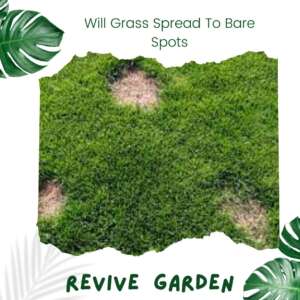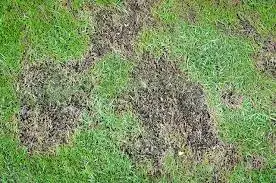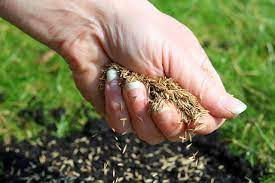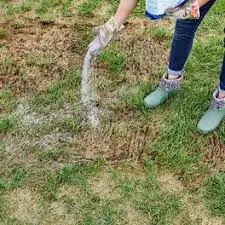Table of Contents
 You usually want to take immediate action when you notice bald spots on your grass. What you should do to restore missing grass segments is dependent on the type of grass you have.
You usually want to take immediate action when you notice bald spots on your grass. What you should do to restore missing grass segments is dependent on the type of grass you have.
Some homeowners may be unsure if bare patches of their lawn will fill in naturally or if they should take the time and effort to repair and reseed the area.
This article will explain the causes of bare spots on a lawn, and why some grasses will automatically fill in and heal bare places while other varieties of lawn turf will require human intervention.
Causes of the Bare Spots on the lawn
Overuse, poor soil, pet urine, grub infestation, chemical spills, fungal disease, buried pebbles, and other factors can all contribute to bare patches on an otherwise healthy lawn. While there are several methods for properly patching these Bare Spots, it is essential to identify and eliminate the underlying cause to prevent the recurrence of the issue. Here are the causes of bare spots in the grass:
- Humans and animals are the primary culprits regarding bare patches on a lawn. Your lawn will have more bare spots if you have dogs or kids roaming around on it than if your neighbors don’t have either.
- Animals that dig, scratch, or use your yard as a toilet will essentially doom patches of grass, while children who jump and run around damage the grass by pulling it up from the roots.
- Bald spots can also be caused by barbecues, applying too much fertilizer in one area, or leaking gas while refueling the lawn mower. It’s possible that the lawn is experiencing growth issues or is sick.

- A child’s toy or an adult’s tool may go lost in the grass and subsequently buried. When this occurs, the area immediately above it may become barren.
- In addition, your grass could perish from a lack of sunshine if you begin fall cleanup but let the leaves remain on the lawn for weeks before bagging them up and composting them.
- Those bald patches didn’t appear for any purpose at all. Irregularities like these usually indicate trouble has arisen.
A Guide to Filling up Your Lawn’s Bare Areas
If you’re wondering if grass spreads on its own, it’s probably because you want to avoid unsightly patches on your lawn. As a first step, figure out what’s causing the thinning. In the future, this won’t be as likely to happen again.
Many different things can cause bald spots. There could be the effect of the chemical spill, or your dog could have developed a habit of defecating in the exact locations on the grass.
Different approaches will be necessary to address the various root problems (some are easier to fix than others). However, getting your lawn back on track will require action to solve the issue producing your bare spots.
When a solution has been adopted, you can plant new grass in the bald areas. Some homeowners may wonder if they may toss grass seeds on their lawns at this stage.
Unfortunately, the clay-like soil in Memphis, Tennessee, makes it difficult for grass seeds to sprout if you put them down in apparent barren places. Usually, it just sits on the surface of the ground, doing little good.
Aerating
If you aerate your lawn first, it will break up the clay in the soil, and your grass may “breathe.” Soil plugs (or “cores”) are removed to create tiny holes during an aeration operation. As a result, more air, water, and nutrients may reach the root zone of your existing lawn, which will help it flourish.
Over Seeding

Overseeding comes after this service and gives the new seeds the best possible chance of germinating. This is because you are ensuring excellent seed-to-soil contact.
Simply scattering grass seed over an existing lawn won’t work as well as creating holes in the ground and letting the seeds fall into them. This is ideal for them since it kick-starts their maturation process. If a seed is scattered over the earth, it is often blown or shifted before it has a chance to germinate and flourish.
The Use of Sod
The fastest approach to fixing bald spots on the lawn and having lush, attractive grass is to learn how to do it with sod. You should cover more prominent bare areas with sod, but minor ones can be patched with plugs—small chunks of sod, ranging in size from about 1 1/2 to 3 inches.

It is recommended that plant the plugs in empty spaces and fill up the soil between them. Immediately after planting the pins in the ground, water them thoroughly and fertilize them with phosphorus to promote rapid root development. Water the treated place every day for at least two weeks until the plant’s roots have become established. About a month after you’ve planted the plugs, you should give them another round of fertilizer.
You can enjoy green grass faster than overseeding, but this method requires more work. Each plug will need a hole in which to be inserted. If you’re going to plant plugs, do it in the spring.
Can Grass Grow in Bare Spots?
Two of the most frequent types of grass in lawns in the United States are Kentucky bluegrass and Bermuda grass. The grass should extend to cover the empty spaces. Those grasses are spread by runners, stolons (similar to vines), and rhizomes (identical to stems) that grow above and below ground. They send out new shoots from the mother plant, he says, and will spread to fill in gaps.
St. Augustine, centipede grass, and zoysia grass are among more options for “running” grasses in the south. Crawling red fescue is a viable choice in the north.
The southern hemisphere is likelier to feature a preexisting spreading grass. Many northern types of grass, especially bunch-type grasses, don’t spread. Therefore reseeding is often necessary to encourage grass to cover bare spots. Some options for patching your lawn are perennial ryegrass, chewing’s fescue, and tall fescue. It should be important that tall fescue can only be used to patch up an already established tall fescue lawn.
Tall fescue doesn’t play well with others. If used as an over seeder or to patch damaged grass in, say, a Kentucky bluegrass lawn or a Bermuda grass lawn, it can get clumpy and ugly.
End Note
This article presented a complete guide to filling the bare spots, its causes, and a 3-step solution including aerating, overseeding, and the use of Sod and the best result of the treatment. If you are facing the same situation then this article will provide you the useful information.
